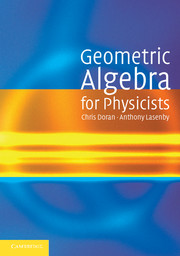Book contents
- Frontmatter
- Contents
- Preface
- Notation
- 1 Introduction
- 2 Geometric algebra in two and three dimensions
- 3 Classical mechanics
- 4 Foundations of geometric algebra
- 5 Relativity and spacetime
- 6 Geometric calculus
- 7 Classical electrodynamics
- 8 Quantum theory and spinors
- 9 Multiparticle states and quantum entanglement
- 10 Geometry
- 11 Further topics in calculus and group theory
- 12 Lagrangian and Hamiltonian techniques
- 13 Symmetry and gauge theory
- 14 Gravitation
- Bibliography
- Index
8 - Quantum theory and spinors
Published online by Cambridge University Press: 05 January 2013
- Frontmatter
- Contents
- Preface
- Notation
- 1 Introduction
- 2 Geometric algebra in two and three dimensions
- 3 Classical mechanics
- 4 Foundations of geometric algebra
- 5 Relativity and spacetime
- 6 Geometric calculus
- 7 Classical electrodynamics
- 8 Quantum theory and spinors
- 9 Multiparticle states and quantum entanglement
- 10 Geometry
- 11 Further topics in calculus and group theory
- 12 Lagrangian and Hamiltonian techniques
- 13 Symmetry and gauge theory
- 14 Gravitation
- Bibliography
- Index
Summary
In this chapter we study the application of geometric algebra to both nonrelativistic and relativistic quantum mechanics. We concentrate on the quantum theory of spin-1/2 particles, whose dynamics is described by the Pauli and Dirac equations. For interactions where spin and relativity are not important the dynamics reduces to that of the Schrödinger equation. There are many good textbooks describing this topic and we will make no attempt to cover it here. We assume, furthermore, that most readers have a basic understanding of quantum mechanics, and are familiar with the concepts of states and operators.
Both the Pauli and Dirac matrices arise naturally as representations of the geometric algebras of space and spacetime. It is no surprise, then, that much of quantum theory finds a natural expression within geometric algebra. To achieve this, however, one must reconsider the standard interpretation of the quantum spin operators. Like much discussion of the interpretation of quantum theory, certain issues raised here are controversial. There is no question about the validity of our algebraic approach, however, and little doubt about its advantages. Whether the algebraic simplifications obtained here are indicative of a deeper structure embedded in quantum mechanics is an open question.
In this chapter we only consider the quantum theory of single particles in background fields. Multiparticle systems are considered in the following chapter.
- Type
- Chapter
- Information
- Geometric Algebra for Physicists , pp. 267 - 308Publisher: Cambridge University PressPrint publication year: 2003



